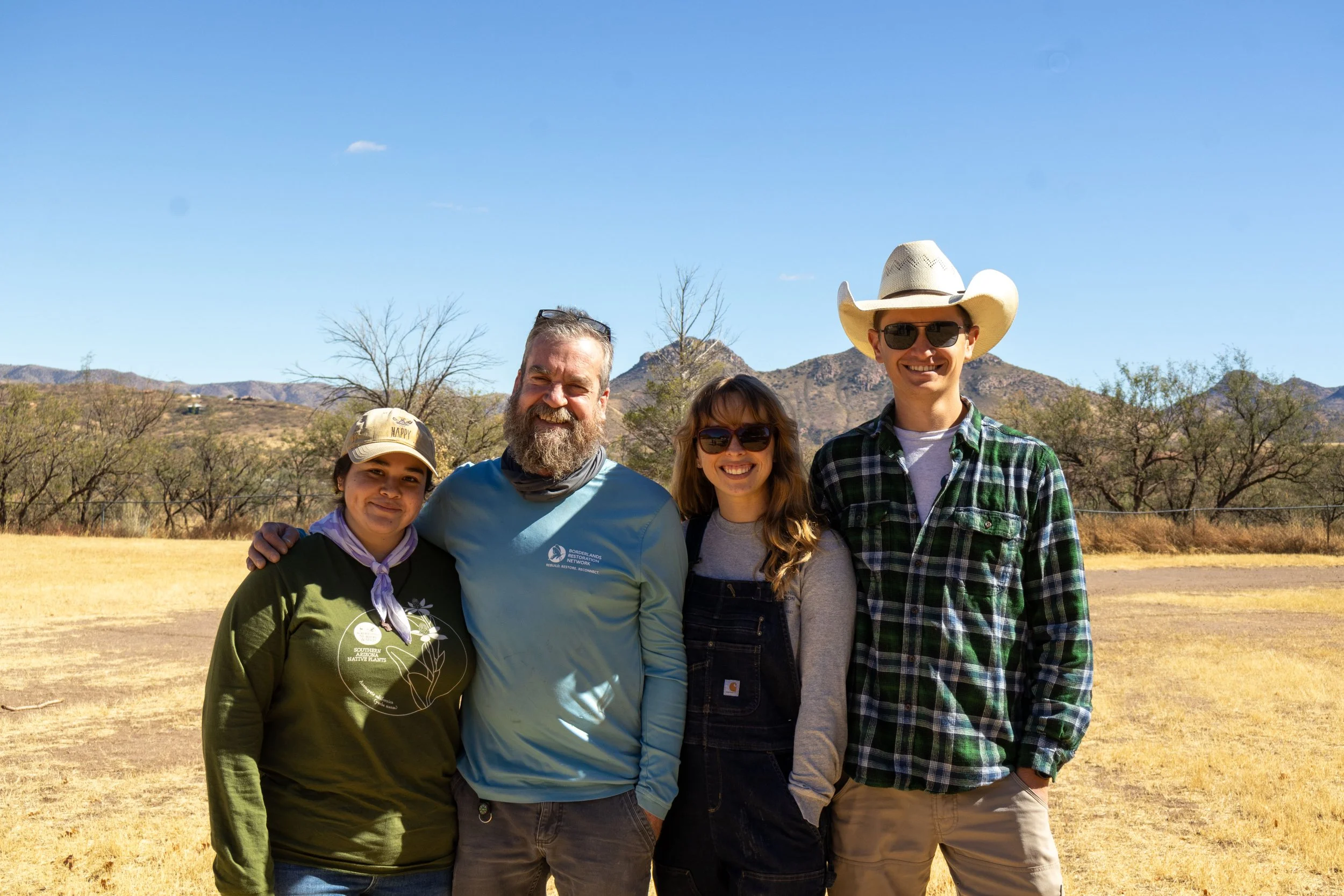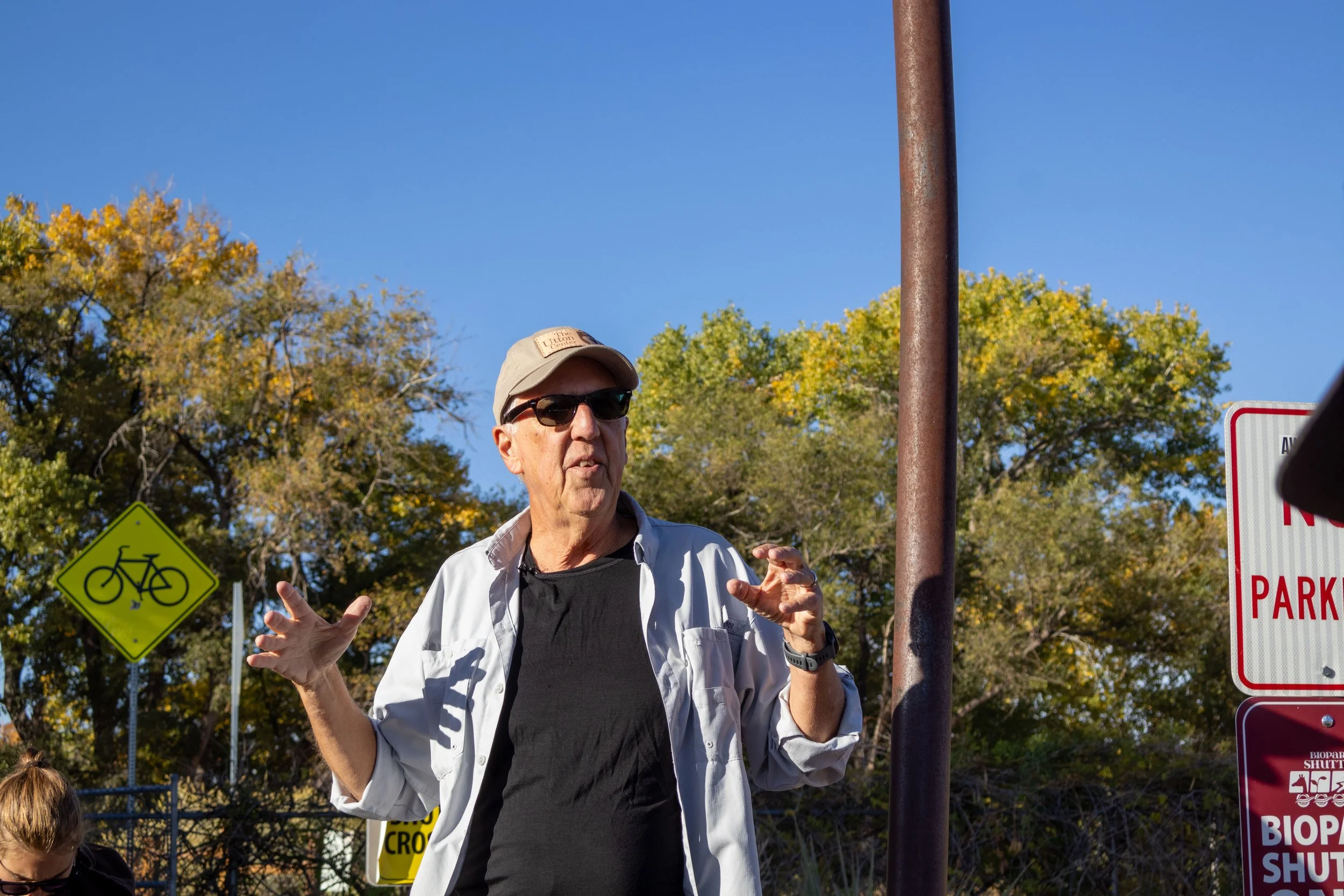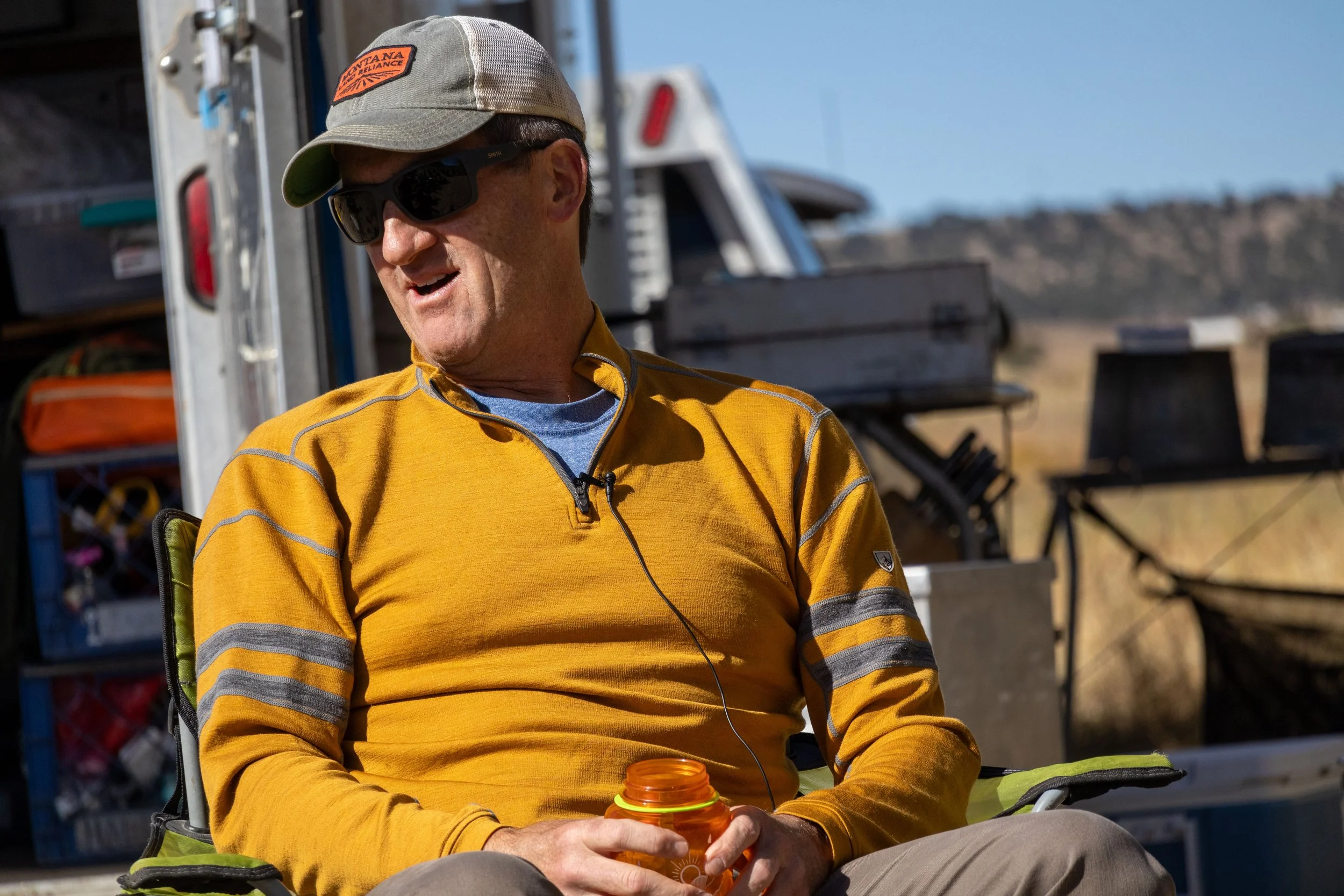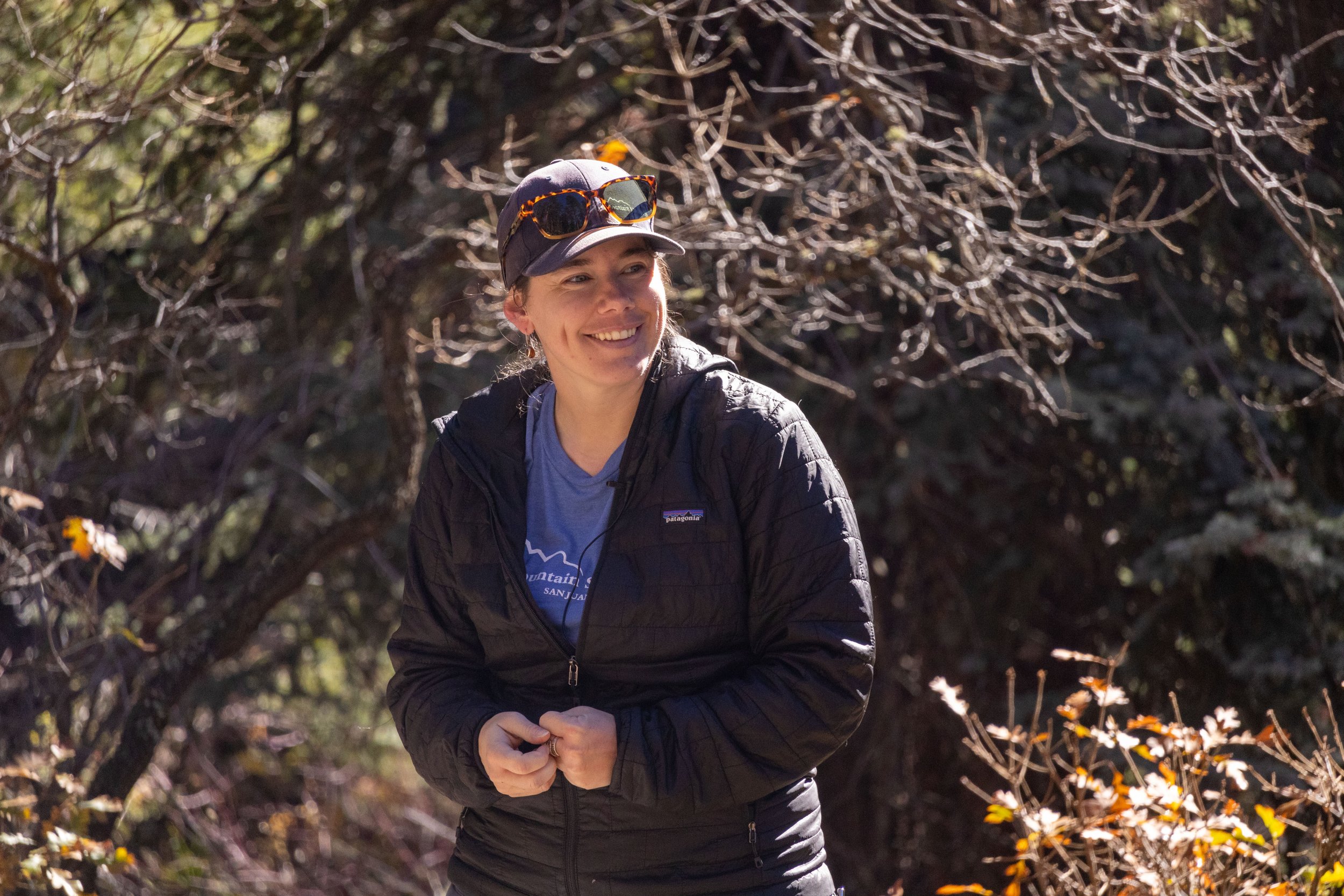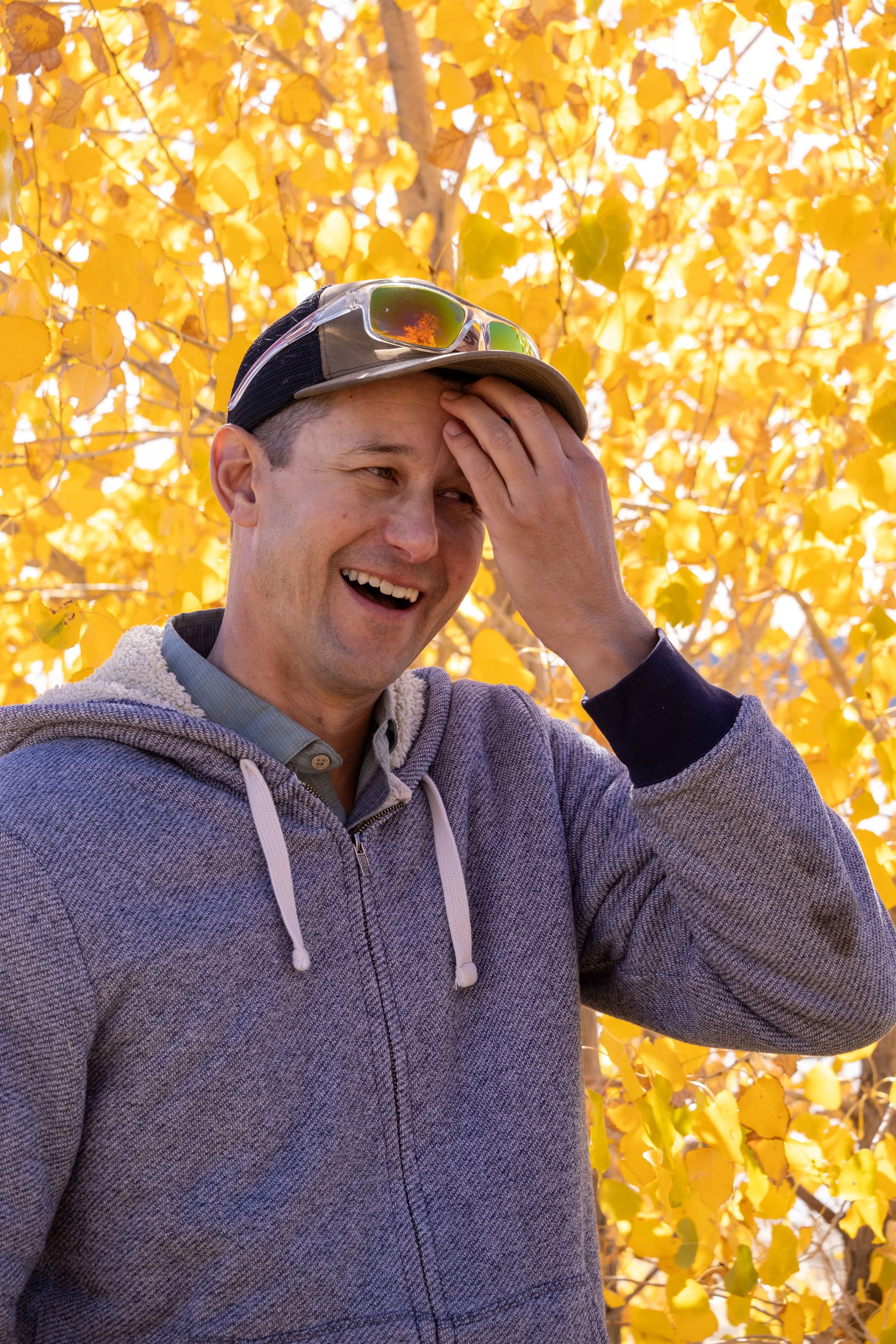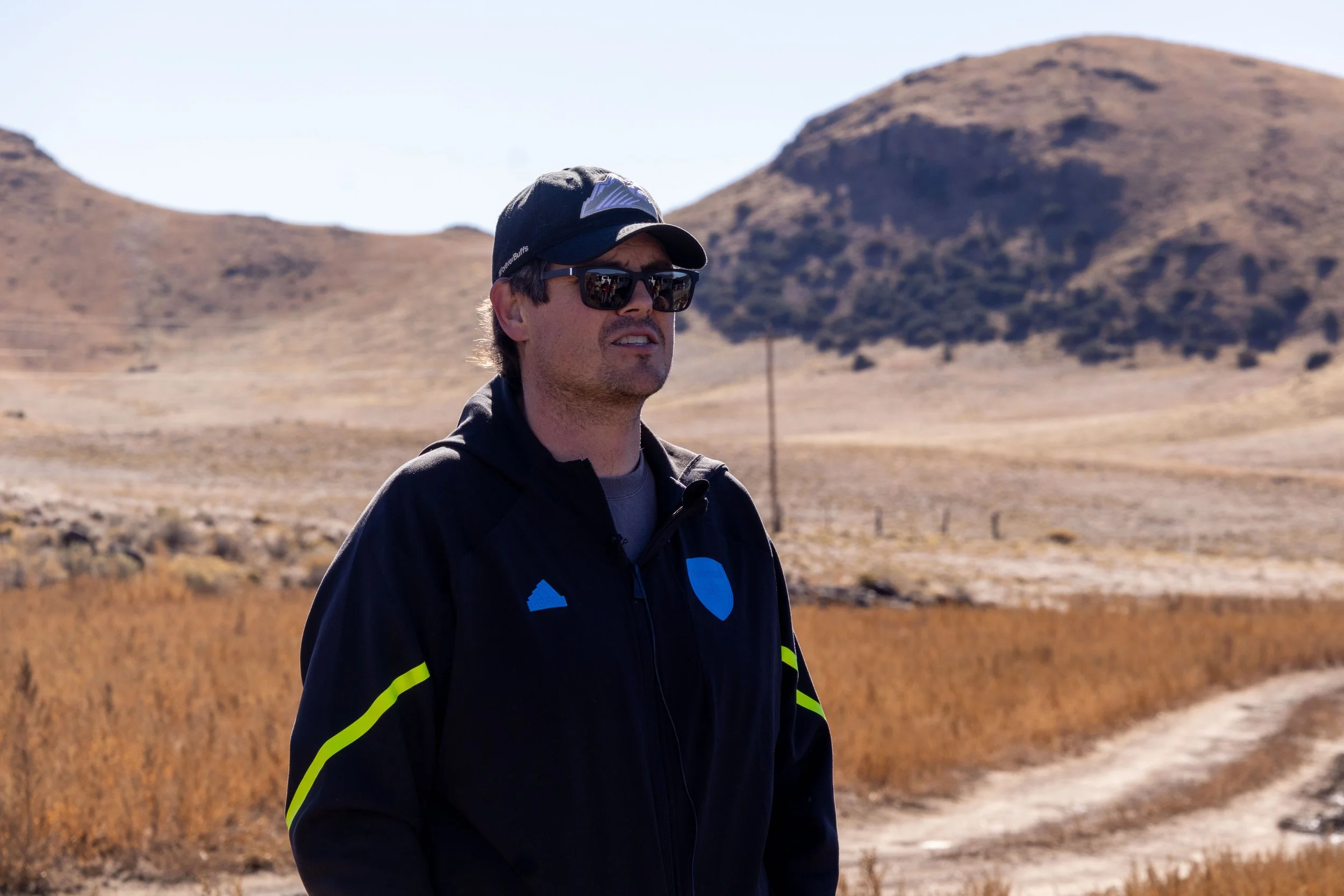Meet our Educators: Ashley Ahearn
Ashley Ahearn
Professional Podcaster
Methow Valley and Johnston Wilderness Cabin, WA
August 26 - September 3 and November 22 - November 28, 2024
For one of the first weeks and final weeks of the program, we had the pleasure of working with Ashley Ahearn, award-winning journalist and pocaster. Her most recent project is a podcast series for NPR called “Mustang,” which follows her journey training a wild horse and explores the complicated politics of horse management in the West.
When we pulled into Ashley’s property in the Methow Valley back in late August, she greeted us stylishly on horseback and immediately made us feel welcome. The rolling hills of the valley were perfect to explore, and her beautiful renovated grain bin- complete with stained glass windows- was a cozy place to work.
During our time with her, we learned about the tools of building a podcast, from the moment we start recording to when we arrange clips in our editing software. She stressed the importance of making a good first impression on our speakers, always recording ambient sound, and getting at what she called “the heart tape.”
Ashley worked hard to get us acquainted with not only the strategies of creating a good podcast, but also with the unspoken rules of her new community, where we were beginning our Semester-long journey. She reminded us to never ask a farmer how many cows he has, because that’s about the same as asking how much money he has in his bank account- “it’s not country polite.” She was very open with us about her initial struggles to integrate into a community where she stands as an outlier- however, it became very obvious to us how deeply connected she had become to her neighbors, some of whom we were able to meet during the week.
Overall, Ashley was an incredible resource to us at a time where many of us were overwhelmed with new technology and storytelling mediums. She reminded us that we were at “Rough Draft Ranch”- where the goal was always to workshop and ask for help if we needed it.
We were all excited to see Ashley when we arrived back at Johnston Wilderness Campus in late November. Just like we remembered, she was incredibly present during all of her time with us. She spent a lot of time helping us with the scripts of our final podcasts, both collectively and individually. She also laughed with us around the fire after dinner, encouraged us to go on runs with her newest puppy, and even watched “Red, White, and Royal Blue” with us after many had gone to bed.
by Alice O’Brien
Meet our Guests: Katie Horn and Debbie Van Dooremolen
Katie Horn and Debbie Van Dooremolen
Public Affairs Manager and Biologist, Southern Nevada Water Authority
Las Vegas, NV
November 18, 2024
It’s a warm November morning in Las Vegas as we stand overlooking Sin City – helicopters fly through the thick smear of smog on the horizon of casinos and hotels. We’re joined by Katie Horn and Debbie Van Dooremolen from the Southern Nevada Water Authority (SNWA) on a rocky knoll scattered with broken glass and other paraphernalia. Both strain their voices to talk over the dull roar of the highway. What we’re focused on today is the winding belt of the river and wetlands that starkly contrast the surrounding xeric shrubland of the Mojave Desert.
Both women work for the Southern Nevada Water Authority which was formed in 1991 as a conglomerate of water purveyors in the Las Vegas area. This way, the SNWA acts as one voice on the river to reduce conflict in the region. Las Vegas receives less than 1% of the Colorado River flow and all of it must meet the most efficient use with rising populations and temperatures.“This is just the new scenario moving forward, and climate change is going to make those conditions more severe. It's going to be hotter. People are going to be using more water longer to meet those demands, so we're planning for just a bad day every year,” Katie, the Public Affairs manager tells us. And it’s true: in recent years there’s been a moratorium on grass lawns, golf courses, and pools. “You don't get to have what the weather provides in other states,” she reminds us.
Historically, the Las Vegas wash was dry. It wasn’t until the early 1950s when the first treated urban runoff from the city made its way through the historic wash to Lake Mead. As development increased exponentially, so did the runoff. By the 1990s, the river had downcut severely, and by 1997, perchlorate was found in the wash.
Debbie Van Dooremolen, a biologist with the SNWA, tells us that everyone knew something had to be done, and the SNWA had to lead that effort. That same year, the water quality citizens advisory was formed to address the pressing issues surrounding the wash. With the formation of the advisory came amendments to the Las Vegas Water Management Plan, the establishment of the wash as a protected wetlands, and the construction of weirs to support bank stability from continued erosion.
These days, the wash springs with life. People bike and run on the trails, coyotes trot through the saltbrush, and the endangered Southwestern Willow Flycatcher has returned. “We all rely on it,” Debbie says, gesturing to the now perennial stream. The Las Vegas wash stands as a testimony to community and ecological resilience in the face of climate change.
by Gwen Marbet
Meet our Guests: Aspen Thies, Zach Farley, Nicole Luna, and Dalton Thrantham
Aspen Thies, Zach Farley, Nicole Luna, and Dalton Thrantham
Watershed Restoration Crew - Borderlands Restoration Network
Patagonia, AZ
November 4, 2024
The shaded canopy of mesquite trees overshadows a dry stream bed as the desert sun shines down the crisp morning. We are in the Sky Islands region. I walk with careful steps, my arms hugged around a gathering of carefully selected rocks picked from the adjacent hillside. Over the thorn bush I step, my calves hugged snugly in a comforting manner by my snake gaiters, down I step dumping my load into a selected bit of stream bed, my arms feel relief from the weight. A pile of rocks grows, and with the direction of Nicole we begin passing and stacking the rocks one by one into and across the stream bed. We are building a one rock dam structure, a type of erosion control structure serving as a physical barrier to slow water as it moves over the earth surface.
Erosion control is one of many programs at Borderlands Restoration Network, a non-profit in the southern Arizona border region working to rebuild healthy ecosystems, restore habitat, and reconnect communities to the land through environmental learning. We met with Zach Farley, Aspen Thies, Nicole Luna, and Dalton Trantham as part of the watershed restoration program. This dynamic crew spends their days building structures in the field working with other non-profits, government and state agencies, and individuals in order to repair and protect landscapes. Since the inception of the watershed sector of Borderlands Restoration Network 4,000 erosion control structures have been installed across South Eastern Arizona improving hydrologic function and soil conditions to enhance wildlife habitat and recharge shallow groundwater tables.
by Cameron Collister
Meet our Guests: Francesca Claverie
Francesca Claverie
Native Plant Program Director at Borderlands Restoration Network
Patagonia, AZ
November 4, 2024
Francesca Claverie led our group through the old metal gate onto the Borderlands Restoration Network’s six-acre native plant nursery and farm. We parked next to a collection of small sheds and greenhouses, where Francesca greeted us with a cheerful smile, her round cheeks glowing beneath her wide-brimmed hat and pink sunglasses. We huddled together to shield ourselves from the wind as Francesca spoke about the importance of the Native Plant Project. For the past decade, she has dedicated her time and energy to nurturing the nursery's initiatives aimed at protecting natural habitats and preserving biodiversity. She described spending countless hours learning the unique needs of native plants and figuring out how to help each one thrive. Unlike domesticated plants, these seeds have very particular requirements to sprout, and Francesca is passionate about discovering the best methods for growing them. Currently, the farm is cultivating about 200 different plant species. While we spoke, her fellow staff members were out collecting more seeds from public land— a slow process, done carefully to avoid overharvesting from any single plant. Francesca emphasized the need for more farms with similar missions to meet the growing demand for seeds for ecological restoration, as the current supply cannot keep up.
Next, she led us into the warmth of the greenhouse, away from the wind. The smell of damp soil filling the air. Francesca walked along the tables of young plants, looking completely at ease in the environment. This greenhouse was home to two of her favorite projects, and light danced in her eyes as she explained them. As she put it, they were growing prickly milkweed plants to support the "sexy" monarch butterflies, and "sexy" agave plants to provide nectar for the often-overlooked nectar-feeding bats. Both the milkweed and agave are becoming increasingly rare, and more need to be grown to support these crucial populations. By the end of the day, Francesca had taught us all to find inspiration in little plants of the desert.
by Cambria Barlett
Meet our Guests: Michael Clifford
Michael Clifford
Conservation Biologist for The Nature Conservancy
Parumph, Nevada
November 13, 2024
Strips of pink sky cradle navy blue layers of mountains below. We are gathered on a large expanse of shrubby desert, surrounded by mountains on all sides. We carefully avoid stepping on cryptobiotic soil as we make our way to the solar farm. Blocking our path is a chain link fence, within it, the navy blue of acres of solar panels facing the sky. Near the bottom of the fence is a small rectangular gap, perfectly tortoise sized.
In Parumph, Nevada, we met Michael Clifford, a Conservation Scientist from the Nature Conservancy. He tells us stories of various desert animals including the endangered desert tortoises that exist within this unassuming landscape. This stretch of desert is part of the Amargosa Watershed, a crucial watershed for endemic species such as the Devil’s Hole Pupfish, Southwestern Willow Flycatcher, and Amargosa toad. For these creatures, the introduction of recent development in the area such as large scale solar disturbs access to this crucial habitat.
With The Nature Conservancy, Michael works to limit these projects from developing on specific habitat spaces. When development is approved, he advocates for habitat mitigation strategies. With Michael’s help, the nonprofit has purchased and protected various sections of imperative habitat, including the ranch we are camping on.
As a massive influx of proposed “clean energy” solar and lithium projects pop up in this region of the Mojave, Michael is working tirelessly to calculate and advocate for the subsequent environmental impacts, as well as identify the least harmful locations for these projects. He describes the root of the dilemma as “balancing biodiversity with climate change solutions.”
by Sofia Defanti
Meet our Guests: Jordan Sene
Jordan Sene
Meet our Guests: John Fleck
John Fleck
Author, journalist, and Director of Education at the University of New Mexico
Albuquerque, NM
October 28th, 2024
As John Fleck, a self proclaimed “river nerd,” took us on a tour of Albuquerque, he emphasized how visiting the river was essential to understanding the city. John, a class of 1981 Whittie, is the current director of the University of New Mexico’s Water Resource Program. By trade, he is a journalist. He has dedicated over 35 years writing for various newspapers, including the Albuquerque journal.
As we stood under the yellowing cottonwood trees, gazing out onto the low flowing Rio Grande, John explained how the series of villages along the Rio Grande came together to address their community’s water needs as it transformed into the city of Albuquerque. He explained that where we were standing at Tingley Beach was once a wetland. In order to build the city, major infrastructure was put in place to tame the meandering and periodic flooding of the Rio Grande. In the 1920’s the Middle Rio Grande Conservancy was formed and they carried out a series of projects including building levees around the river as well as a system of ditches throughout the city to provide irrigation water.
John showed us around a series of irrigation ditches throughout the city that serve as a forested recreation path for community members. These ditches that are integrated into the city reflect the long standing history of agriculture in the valley that informs the city’s culture and infrastructure to this day. We left out tour of Albuquerque led by John with a new understanding of how water use shapes life in a city, especially one located in a desert where water can be scarce.
By Johanna Duncan
Meet our Guests: Marilyn Russell
Marilyn Russell
La Veta Trails Founder
La Veta, CO
October 24, 2024
We met Marilyn Russell of La Veta Trails on a patch of dirt sculpted into a trail across from the old school, on top of the older school, in La Veta, Colorado in the Huerfano River valley. In the small town of 800 people, looking up at the Spanish Peaks, Westies congregated to engage in some service learning. The La Veta Trails group helps to maintain 186,156 acres of land and maintains over 100 miles of trail.
As a retired public policy researcher, Marilyn knows firsthand the importance of access to community resources like walking and hiking trails. After moving to La Veta, Marilyn noticed the lack of accessible trails close to town, with residents pointing towards the Spanish Peaks for the closest hiking. After making a light-hearted joke about her age, Marilyn knew the town would benefit from closer hiking and walking trails. La Veta Trails group worked to revamp the walking trail in town, originally built by the school but partially neglected over time.
Marilyn also taught Westies a brief history of the culture-rich region. She wanted a change from the city, and happily reported that the county has only two stoplights! Westies engaged in service learning, pulling invasive weeds in the walking loop in town, Canadian thistle, Cheatgrass, and Russian thistle. Many hands make light work, and Westies worked hard to reduce the invasive species and rebuild parts of the trail. Service learning is a key part of Semester In the West, allowing students to gain a deeper understanding and engagement with the community.
by Owen Schott
Meet our Guests: Mike Wilson
Mike Wilson
Tohono O’odham Activist
Tucson, AZ
November 5, 2024
In a small classroom at Quincy Douglas Library in Tucson, Arizona, we talked to Mike who welcomed us warmly.
Michael "Mike" Wilson is a Tohono O’odham human rights activist who placed water for undocumented migrants on Tohono O’odham tribal land for 12 years, starting in early 2002. The deadliest immigration pathway to America is located along tribal territory, and Tribal police estimate that at least 1500 people come into tribal lands from Mexico daily, with most dying in the process. He aided immigrants by putting out water jugs on migrant trails but experienced heavy resistance from border patrol, tribal government, and the church, was threatened with banishment from the Tribe, and being put on a terrorist watch list.
He shared his experience in the Army as a special forces military advisor in El Salvador, and explained the story of the “dark side of Mike Wilson,” a story from working to stop El Salvadorans from immigrating to America, to aiding undocumented migrants crossing the border. Mike shows his transformation like a play, using water bottles and his hand to visualize the details of the day while explaining his thoughts in the head at the moment, shivering his voice towards the end. It was extremely powerful, one that had us questioning what is justice and “What Side Are You On?” Most of the problems are not black and white but 99.99% are gray, and in those gray, there are different shades of gray like light gray, dark gray, misty gray, says Mike.
Mike also talked to us about how the tribal government sovereignty on the reservation is a myth. Border Patrol agents by the hundreds are on tribal lands all along the border. Border Patrol is a federal law enforcement agency with primary law enforcement jurisdiction on all federal lands, including reservations. Moreover, because Congress approves reservation, sovereignty and money, the Tribes do not want to risk losing its right by not allowing border patrol agents. Mike expresses anger as he tells us the long history of harassment, intimidation, and imprisonment of tribal members, including the night of May 18, 2023, a mile away from the US-Mexican border, when a tribal member was shot and killed in front of his house and family by nine Border Patrol agents.
We ended our conversation buying Mike’s book “What Side Are You On?” which explains most of the issues we talked to in detail through Mike's perspective from his personal stories.
by Ayano Yoshikawa
Meet our Guests: The Salton Sea
The Salton Sea
Imperial Valley, CA
November 9, 2024
Fish bones crunch as my foot sinks into the slimy mud of the lakeshore. Rusted bolts tack together a collapsed dock, surrounded by the rims of small boats sunk in the sand. The smell of rotten eggs and decay penetrates our nostrils, and the sun beats overhead. A hazy fog conceals the far side of the lake, shimmering like a mirage. On a pole jutting out of the sand, a red sticker reads: PARDON OUR DUST. WE ARE SHRINKING THE SEA TO PROFIT IID. (*Imperial Irrigation District)
Bombay Beach is one of the last communities remaining on the shores of the Salton Sea. Once a bustling, stylish resort town for the Hollywood elite, it now has a population of just over 200, and one of the highest rates of asthma and respiratory health problems in the state. California’s largest inland lake emerged as a result of a 1905 accident, when an overly ambitious engineer attempted to divert water from the Colorado River into irrigation canals in the valley. Heavy floods and a particularly rainy season caused the diversion to burst, flooding the Salton Basin nonstop for over two years. Between the 1920s and 1960s, the man-made lake attracted large populations of fish, migratory birds (along their North-South flyways), and a booming recreation hub for vacationers traveling from the LA area.
But, as all closed lakes do, it got saltier. Droughts, diversions, and an increasing agricultural efficiency caused the lake input (almost entirely agricultural runoff) to dwindle, and the mass die-offs began. Algae blooms created oxygen-starved zones, killing off organic life and blowing noxious hydrogen sulfide clouds across the nearby towns. Tourists turned their noses and began to leave. Pelicans, grebes, and waterbirds died by the tens of thousands. The shores of the Salton Sea retreated faster than ever, and expanses of lakebed cracked, dried, and blew fine dust mixed with selenium, arsenic, pesticides, and heavy metals over the fields of lettuce, broccoli, and alfalfa that cover the Imperial Valley, thirstily sucking water from the Colorado River artery.
We met with managers and engineers from a company called ILiAD Technologies, working on Project ATLIS, a cutting-edge plan to modify geothermal plants in the area to extract lithium, as a byproduct, from groundwater brine. Promising to use minimal land, consume small amounts of water, and expel little carbon dioxide, it’s the key to the future of the global green energy transition…in theory. Carefully aligning itself with the Department of Defense's critical mineral list, it should be an apolitical resource to supply nearly half a million EV lithium batteries to the global market each year. Five years ago it was a $700 million project, and now, it’s valued between $1.3 and 1.7 billion. Invest your stocks wisely, everyone.
We walk between walls of glass bottles surrounding crumbling RVs layered in woven blankets. Concrete blocks prop up shipping containers, covered in colorfully psychedelic patterns. Rusted-out cars are dressed in fishnets and alien antennae, smiling at our passing vehicles. Bicycle wheels attached to towers of lumber and rebar spin in the wind, clicking as they go. A wall of CRT TVs displays colorful painted statements, like: BOW BEFORE YOUR GODS, MEN FEEL NOTHING, INSECURITY WE TRUST, and my personal favorite, YOU NEED MORE STUFF. On the outskirts of the Imperial Valley, the off-the-grid unincorporated community of Slab City lies strewn across the desert. We wander the art galleries built decades prior, human life rippling and reforming in melting sculptures of discarded waste.
Our campsite is an ancient lakebed. The finely ground silt sinks as we set up our tents and climb over the bulldozed mountains of rubble. The sun sets beautifully, splashing bloody hues of crimson and soft pinks across the tiny clouds above. The geothermal plants rumble nonstop in the distance, pumping steam and illuminating our horizon with bright lights. There is no solution, our professor says, to the issue of the sea. Some say we section it off so that birds might be able to use a fifth of slightly fresher lakewater. Some suggest we let it dry, and then spray the surface with water to suppress the dust. Some want to pump water from the Mississippi over the Rockies to replenish the Colorado River. And most radical of all, some suggest we feed our cows less alfalfa.
There is no young, stylish, “save the lake” committee. The lake will grow saltier, and the dust will continue to blow. We sit under the cooling desert sky, feeling the weight of it all. The silence that fills the spaces between rumbling steam pipes and fading light. This is California’s great, man-made environmental disaster, one we’ve chosen to let die.
by Henry Anderson
Meet our Guests: Helena Cappon
Helena Cappon
Co-owner and Operator, Gub Gub’s Pizza and Ice Cream,
Walsenburg, CO
October 25, 2024
Helena Cappon stands in front of 21 pizza-eating college students in Walsenburg, Colorado, and explains how she and her fiance, Thomas, started Gub Gub’s Pizza and Ice Cream. She motions across the busy intersection, and says, “We would sit in that Carl's Jr. parking lot, during the pandemic, and have little dates and eat our cheeseburgers over there. And I would joke to him, I'd be like, buy me that gas station.”
Helena is originally from Denver and lived on Long Island, NY from ages 5-10. She met Thomas at the University of Denver and graduated in 2019. When the pandemic hit in 2020, she moved in with her parents, who had a house in Walsenburg.
Helena recounts why she and Thomas wanted to start a restaurant in the first place: “Being students from low-income backgrounds in very different communities, one thing that really brought us together was our passion for creating more resources and opportunity… especially in a low-income community in rural America, like Walsenburg.” Walsenburg is the county seat of Huerfano County, the poorest county along I-25 in Colorado, despite the 3.5 million-plus cars per year traveling through Walsenburg on the interstate. In the late 19th and early 20th centuries, Walsenburg was a booming coal town. Unfortunately, Walsenburg was hit hard by the coal market’s decline, with the last area mine closing in 1973. The city population was just 3,049 in the 2020 census, down from its peak of 5,596 in 1950.
Helena’s dad, Jack Cappon, is a contractor specializing in restaurant renovations. Thomas is a baker and 5th-generation Walsenburgian. “We were like, let's use the skill set we have to make the most impact that we can,” Helena says. The trio originally thought they would open a bakery, but Walsenburg already had bakeries. Helena shares, “I read an article like three years ago, saying that most successful main streets in the United States include an ice cream shop, a pizza shop, and a bookstore.” In a city devoid of mom-and-pop pizza shops, Helena, Thomas, and Jack decided to fill the niche.
Jack named Gub Gub’s after the family cat, which is named after the pig in Dr. Doolittle. Gub Gub’s first opened in 2021 at the Walsenburg Mercantile, a business incubator. For business advice and a dough recipe, Helena turned to her childhood pizza spot: Carlo’s Pizza in Port Washington on Long Island. Helena notes that it “took a couple years to figure out the altitude and the dryness.”
As Gub Gub’s served pizza over the counter at the Mercantile, Helena, Thomas, Jack, and their families worked to convert the old gas station at 7th and Main into a vibrant pizza establishment. Finally, in the summer of 2023, Gub Gub’s got funding for tank mitigation, allowing them to move forward with renovations. Gub Gub’s had its grand opening on October 19th, just six days before our Semester in the West (SITW) group visited.
Locals and travelers sat under the former gas station canopy and enjoyed hot and fresh pizza. I walked over to a picnic table under an umbrella, and took a couple slices from the pies Gub Gub’s had made for SITW. Gub Gub’s bakes their pizza at 600°F in a natural gas oven. The slices folded well. The chewy dough, oregano, and low-moisture mozzarella tasted just like the New York-style pizza I grew up eating in Portland.
A ring of car tires and building blocks sat invitingly in the corner. “We do not have a ton of… public parks and spaces for kids,” Helena said. “We don't even require people to buy stuff to come and hang out. We have, like, $1 ice cream cones and stuff so they can get a little treat and just go nuts and hang out.” After finishing our pizza and conversation with Helena, 21 Westies went nuts, jumping around on the car tires, building block towers, and of course, enjoying $1 soft serve. We left Gub Gub’s with full stomachs, full hearts, and a newfound appreciation for rural entrepreneurship.
by Jackson Schroeder
Meet our Guests: Stephanie Russo Baca and Casey Ish
Stephanie Russo Baca and Casey Ish
Middle Rio Grande Conservancy District
On the Bosque in Albuquerque, New Mexico
October 29, 2024
A highway of yellowing cottonwoods signals the long lost touch of water. Amongst the blusters of wind, we are introduced to Stephanie Russo Baca, water lawyer and chair of the Middle Rio Grande Conservancy District (MRGCD), and Casey Ish, conservation program and special projects supervisor for MRGCD. They show us around part of Albuquerque’s well-loved Bosque, the woods that fan the edges of the murky Rio Grande. Casey describes how MRGCD strives “to do what the river can't always do by itself, which is to maintain a habitat feature” through the irrigation system that’s been in place for more than a century. Ditches, also known as acequias, spread water from the Rio Grande into the historic floodplain area, irrigating crops and farms throughout the valley.
Born from a now gone – or rather, extremely diminished – floodplain, the Bosque is home to billowing cottonwoods, a chorus of coyotes, and is a refuge for sandhill cranes. As we’re walking, we stumble upon a recent beaver dam installment created over the weekend: a fresh creek, morphing the sandy ground, rushing and bending, willows and reeds stand by in the flooded ground. Casey and Stephanie exclaim that beavers wonderfully, and thankfully, do part of the job of spreading water over the landscape. A stream of color washes over the intermittent grayness – the light blue of invasive Russian Olive trees, burnt fall colors, and the lime greens of grasses.
Thin, brightly orange Salt Cedar spreads like wildfire, bringing with it flames in recent times. Invasive Salt Cedar creates habitat for endangered Southwestern Willow Flycatchers, which makes for a difficult situation for MRGCD. “This gallery did not evolve to regenerate through fire, it evolved to be disrupted and regenerate through flood,” says Casey. Piles of sand and sediment on the banks of the Rio Grande demonstrate this fact.
Red or green? A long standing question in New Mexico, the chile capital of the world, and now a question I pondered myself as I stared into the hot pots warming up red and green chile. After our tour throughout the Bosque with Stephanie and Casey, Stephanie generously invited us into her home and little farm, feeding us a delicious homemade meal (thank you Stephanie!!) of burgers complete with beans, greens from her garden, and goat cheese from her goats. Over lunch, Stephanie talked to us about the complexities of water law, the cultural significance of agriculture in the Rio Grande rift valley, and the role of alfalfa in a water-diminished world.
by Antonia Prinster
Meet our Guests: Nico Estrada and Ethan Schiller
Nico Estrada and Ethan Schiller
Employees of Chispas Farm
Albuquerque, NM
October 30, 2024
Despite the cold snap of the previous night, Chispas Farm radiated warmth. The feeling was due in part to our guides, Nico Estrada and Ethan Schiller, who met us at the gate. Our eyes were met with small fields of crops and cheerfully painted sheds, while our ears heard the various effusions of goats and chickens. We stood in a semi-circle in front of smiling Niko and Ethan, and commenced our tour of Chispas, a small farm in the middle of Albuquerque.
Chispas, meaning “sparks” in Spanish, is named after the land-owner, John Sparks. He bought the land in 2003, and began farming it with a hands-off approach, allowing the employees to shape the space to their needs. Nico and Ethan, two employees of the farm, are using the land to create a community gathering space– while still maintaining the financial aspects required of a commercial farm.
After our tour, we were put to work at three different stations. With Niko, we pulled up eggplant shrubs to ready the field for the first frost. Our group delighted in finding “baby” eggplants hidden under the leaves. With Sal, another employee of Chispas Farm, we picked buckwheat. It was delicate work; each individual seed had to be pulled off the top of the tiny stalks and dropped into a paper bag. We took a brief break to pet the goats, then moved on to the final station with Ethan, where we used scissors to cut the seed heads off amaranth.
We spent the remainder of the afternoon in a shady corner of the farm, reflecting on what we had learned. Thanks to the knowledge and warmth of Chispas Farm’s staff, we left with tangible knowledge of how a small farm in the middle of a city creates community.
by Carlie Johnson
Meet our Guests: John Carron
John Carron
Hydros Consulting
Huerfano River Valley
October 26, 2024
On a blustery afternoon, the Westies met with John Carron, longtime water policy professional and resource engineer. Co-founder of Hydros Consulting firm in Boulder, Colorado, John has been involved in the water and resources field for around three decades. In addition to his work he is also the father to the Semester in the West Field Manager, Abigael Carron and his dedication to both aspects of his life easily shows through in his casual, joking conversation style. He enjoys the problem solving aspect of his job the most. Maybe some of this comes from his background in STEM, but it also seems to come from a place of deep care and consideration for the individuals he works with and for.
In terms of the future of water issues in the Colorado River Basin John says, “It will get sorted out in slow, painful steps.” He reminds the group that water policy takes a very long time to negotiate and that timescales on which environmental policy shifts can be brutal and frustrating, but that change around the vital resource of water will take extremely hard work and perseverance.
At one point a student asks if there is anything that John’s wife and daughter don’t know about his job. He jokingly replies, “I wear a cape.” But I don’t think he’s that far off. His work is imperative to communicating to different people the stakes around water conservation in the Colorado River Basin. He analyzes huge issues and finds ways to solve and settle disagreements around them. He works with policy makers to look at what the general population is willing to give up or take on in the vein of water conservation. In many ways, he really is a superhero.
by Linnea Krig
Meet our Guests: Jewell Coleman
Jewell Coleman
Education Program Manager, Mountain Studies Institute
Durango, CO
October 21, 2024
Jewell Coleman, the Education Program Manager for Mountain Studies Institute met us at the Hermosa Creek trailhead outside of Durango, Colorado. Clad in running shoes and a big puffy, Jewell started our session smiling, with a combination introduction-stretch circle. Mountain Studies Institute is a non-advocacy not-for-profit organization based in the San Juan mountains. The institute consists of several branches: forest health, hydrology, and community science. Jewell's position falls under the purview of the latter. Jewell mostly works with grant programs to get local youth outside, teaching them about the natural world around them.
We spent most of our afternoon with Jewell learning about fire dynamics in the San Juan Region. She spoke to us about the culture of fire suppression in the region and how the figure of Smoky the Bear set the tone for America’s cultural disconnect from fire in our forests. We shadowed Jewell’s curriculum for the day, taking a hike and throwing Native Seed cookies, part of an initiative to give kids an opportunity to have a hands-on impact on the regrowth of native plants following catastrophic fires.
After we finished our hike we made more seed patties for future groups to use! We ended our day with Jewell in the Animas River learning about macro-invertebrates (small water-dwelling bugs and crustaceans) and how they reflect the river system's health, which is intimately connected to forest health. Meeting with Jewell was a wonderfully full-circle experience learning about fire, and how it affects forests, people, animals and watersheds.
by Irving Baldwin
Meet our Guests: James Henderson
James Henderson
Vice President, Colorado Agriculture Bureau
Walsenburg, CO
October 25, 2024
It was a sunny October morning on the shores of Lathrop State Park and the Spanish Peaks were mirrored on the reservoir’s still surface. The Westies sat in a circle with cushiony sand underfoot while we talked with James Henderson about the ins and outs of Colorado water usage. James is the Vice President of Colorado' s Agriculture Bureau and his family has been farming alfalfa and cattle in the San Luis Valley since 1882. He graduated from Colorado State University with a degree in Natural Resource Policy and outdoor recreation.
James describes the basics of the Colorado water rights system while exuberantly gesturing to our surroundings. The Colorado water system works by prior appropriation– meaning first in time first in rights. The earliest water rights belong to the Peoples Ditch in San Luis in 1852, before Colorado even became a state in 1876. Those who have water rights must use it to benefit the people of Colorado. Your water right is based on historical use and how much is consumed. For example, when irrigating crops, the water the farmers have the right to is the water taken in by the crops and not percolated into the water table. James also covered the tensions caused by water– those between community members, the east and west divide, as well as between the states.
Since James is an alfalfa farmer, we asked him why alfalfa, a water-intensive crop, is grown so readily in dry regions of the country. James told us, “It's basically a conversation about free market economics.” We were all at the edge of our seats as he started to discuss the role of economics in farming. It was a new subject that had not been covered much throughout the semester. Also, farms are valuable for wildlife because of the creation of green space– a place that is not developed, James says.
James is a problem solver who likes to work with the system to create solutions for both the agriculture bureau and his family farm. His love for farming comes from his family ties to the San Luis valley. “You gotta understand that that's in my DNA for like, 142 years now, the stewardship of the land, the producing a product that people literally can't live without. My product keeps civilization intact.”
by Caitlyn Taylor
Meet our Guests: Willie Myers
Willie Myers
Potato Farmer, Mountain Valley Produce
Del Norte, CO
October 23, 2024
We’re swimming in statistics: wells pump 800 gallons per minute, 50 million potatoes sit in a shed, and an 8000-foot-deep aquifer runs under layers of stratified sediment. Willie Myers, a sixth-generation farmer whose family has tended this land for over 150 years, speaks quickly as numbers flow from his lips. It seems his brain operates in zeros and ones.
At 7,500 feet above sea level, Mountain Valley Produce sits in the high desert of Colorado’s San Luis Valley. In a valley of methodically constructed crop circles, he owns just twelve. Due to the ever-variable economics of farming, Willie consolidated his operation to focus on producing organic potatoes: fingerlings, purples, yellows, and russets.
While Willie’s parents lived by the adage “The trashcan is just as good a customer as any,” producing over all else, he takes a different approach. A $30,000 monthly water bill and environmental lawsuits targeting his farm push him to think in terms of water scarcity. Willie involves himself in water conservation working groups where he deciphers convoluted water policy and envisions a sustainable future for farmers. Water is limited, yet water is life.
In America, where oligopolies run consumer markets and smaller farmers “perpetually gamble” in our continuously changing climate, the future of farming is grim. Willie says matter-of-factly, “I’m not terribly optimistic about the future. I do it because it’s in my blood.”
by Ava Frans
Meet our Guests: Steve Wolff and Mo Rock
Steve Wolff and Mo Rock
Southwestern Water Conservation District General Manager and Programs Coordinator
Durango, Colorado
October 22, 2024
We met with Steve and Mo alongside the Animas River under a riparian area of quaking aspens, their fall leaves gleaming in the afternoon sun. These two are the entirety of Southwestern Water Conservation District. Together, they fight for water conservation on Colorado's western side of the Continental Divide.
Eighty percent of Colorado’s population lives on the Eastern side of the continental divide, and the same proportion of the state's water is on the West. 26 diversion projects exist from west to east. Together, Steve and Mo advise litigation and monitor diversion projects so that as much water as possible stays on the western side of the state for the rural communities with less of a voice than the larger eastern metropolitan areas.
An essential part of a healthy summer river flow is the snowpack reservoir in the mountains. Climate change is reducing the amount of snowpack created, and making spring melt occur earlier in the year. One of the strategies Southwestern Water Conservation District works on is weather modification through cloud seeding. Particulates are dispersed in the clouds to encourage more precipitation recovery from winter storms over the mountains and increasing the snowpack reservoir.
Working in court cases and community outreach, the duo has many roles that keep them busy. This was a perfect stop to wrap up our visit to Durango, CO.
by Annika Schwartz
Meet our Guests: Susan Behery
Susan Behery
Hydraulic Engineer
Durango, CO
October 19, 2024
Over the course of two days, we were provided insight on the inner workings of a hydrological engineer’s mind. Susan Behery works for the Bureau of Reclamation in the San Juan River Basin. She is responsible for operating the Navajo Dam, working on the Animas-La Plata Project, and supporting the development of other reclamation objectives. Susan has been working with The Bureau of Reclamation for since 2012, with over 15 years of experience in hydrological engineering. With her guidance, we were also able to learn from her colleagues Danielle Urich, Kelsey Deckert, and Brett Griffin.
The Navajo Dam was finished in 1962 with the goal of flood and sediment control, recreation, and to provide water to the Navajo Indian Irrigation Project (NIIP). Due to a lack of federal funding and a shortage of infrastructure within the Navajo Reservation to financially support this project, 62 years later the goal of NIIP has not been achieved. The reservation has still been unable to receive adequate water supply, leaving many homes without running water. Susan expresses hope that the completion of the project is in sight, and the water held by the dam will be diverted to the Navajo Reservation, fulfilling the settlement agreement. Highly accomplished in her field, Susan was an excellent resource to help us wrap our head around some of the many complexities of her work.
by Kiana Potter





